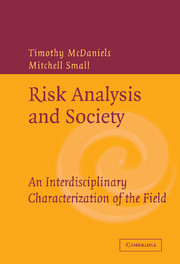Book contents
- Frontmatter
- Contents
- Contributors
- 1 Introduction – Risk Anaysis and Society: An Interdisciplinary Characterization of the Field
- PART ONE FUNDAMENTAL CHARACTER OF RISK
- PART TWO METHODS FOR RISK ASSESSMENT
- PART THREE NEW APPROACHES AND NEEDS FOR RISK MANAGEMENT
- SUMMARY AND FUTURE DIRECTIONS
- Index
- References
1 - Introduction – Risk Anaysis and Society: An Interdisciplinary Characterization of the Field
Published online by Cambridge University Press: 05 June 2012
- Frontmatter
- Contents
- Contributors
- 1 Introduction – Risk Anaysis and Society: An Interdisciplinary Characterization of the Field
- PART ONE FUNDAMENTAL CHARACTER OF RISK
- PART TWO METHODS FOR RISK ASSESSMENT
- PART THREE NEW APPROACHES AND NEEDS FOR RISK MANAGEMENT
- SUMMARY AND FUTURE DIRECTIONS
- Index
- References
Summary
RISK ANALYSIS AND SOCIETY
Being alive means seeking opportunities and taking risks. For people living in modern society at the beginning of the twenty-first century, being alive means grappling with a complex and growing array of risks to the well-being of humans and the natural environment. It also means increasing concern for the how these risks are understood, characterized, and managed. Hence, we have the human dread of and fascination for risk and the increasingly important role of risk analysis within societies.
Since the beginning of human development, risks to health and well-being have led to adaptive responses that open paths for change. When neolithic family groups shared knowledge and resources for combating hunger, thirst, climate, or outside attack, they were trying to manage risks they faced. Jared Diamond's recent book, Guns, Germs, and Steel, presents the complex and fundamental decisions faced by hunter-gatherers when considering whether to adopt food production in place of their traditional foraging way of life (Diamond, 1999). Issues of uncertainty, value trade-offs, community knowledge, outside expertise, ethical dilemmas, and the imposition of risks by others were all part of those choices.
Risk management has been a fundamental motivation for development of social and governance structures over the last 10,000 years. The onset of agricultural production brought increasing population and permanent settlements. Concentrated population in turn led to greater risks of drought, famine, and conquest by others. Settlements thus created the need for infrastructures for managing these risks, such as water supply, food storage, and defenses.
- Type
- Chapter
- Information
- Risk Analysis and SocietyAn Interdisciplinary Characterization of the Field, pp. 1 - 12Publisher: Cambridge University PressPrint publication year: 2003
References
- 4
- Cited by

